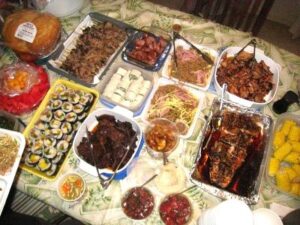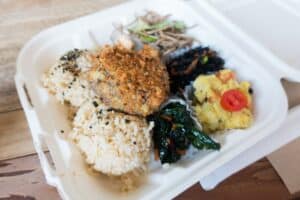There’s nothing quite like finishing a long day in the ocean, skin sun-kissed and toes still sandy, and reaching into the cooler for a bowl of cold, fresh poke. That first bite of seasoned ahi brings it all together —salty, savory, chilled perfection. Whether you’re a local or a visitor discovering it for the first time, Hawaiian poke is more than food — it’s a cultural experience, a comfort, and sometimes, even a celebration. Ahi tuna poke bowls, with their fresh and healthy ingredients, are a favorite summer meal for many, reflecting the traditional flavors of Hawaiian cuisine.
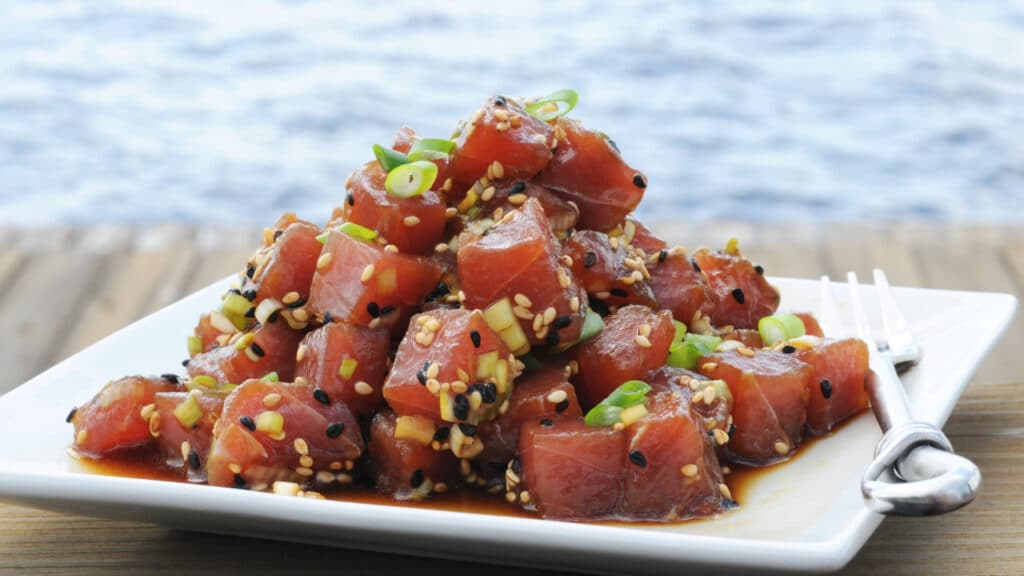
Fresh Tuna Poke (Shutterstock)
What Is Hawaiian Poke?
Poke (pronounced “poh-keh”) means “to slice” or “cut crosswise” in Hawaiian, and traditionally refers to raw fish that’s been cubed, seasoned, and sliced to perfection. A traditional Hawaiian poke bowl features fresh ahi (yellowfin tuna) tossed in Hawaiian sea salt, limu (seaweed), and inamona (roasted kukui nut). Over time, new flavors and ingredients emerged to reflect the islands’ evolving cultural landscape — think sesame oil, soy sauce, sweet onions, chili flakes, and more. Modern poke bowls are made with all kinds of seafood and toppings, but if you’re in Hawai‘i, start with the classic.
“Poke in Hawaii hits different,” writes @IslandEatsDaily. “It’s so fresh, it feels like the ocean is still in the bowl.”
The History and Cultural Significance of Poke
Poke, a traditional Hawaiian dish, has a rich history and cultural significance that dates back to ancient times. It was often served at special occasions and ceremonies, symbolizing community and celebration. Poke was traditionally enjoyed with poi, a classic Hawaiian dish made from fermented taro root, creating a meal that was both nutritious and deeply rooted in the land and sea.
Today, poke has transcended its humble beginnings to become a global phenomenon. While modern variations abound, the traditional Hawaiian poke remains a cherished dish that connects people to the islands’ rich cultural heritage. Whether enjoyed at a family gathering or a beachside picnic, poke continues to be a symbol of Hawaiian hospitality and culinary tradition.
Why Hawai‘i Loves Poke
Poke is as local as a plate lunch and shave ice. It’s at every grocery store, on nearly every menu, and a guaranteed crowd-pleaser at potlucks, beach days, and birthday parties. It’s portable, protein-packed, and customizable. Best of all, it’s served cold — which hits the spot on a warm island day.
After a swim or surf session, there’s almost nothing better than grabbing poke from Foodland or Tamura’s, tossing it in the cooler, and heading back to the beach. It’s fast, delicious, and tastes like home.
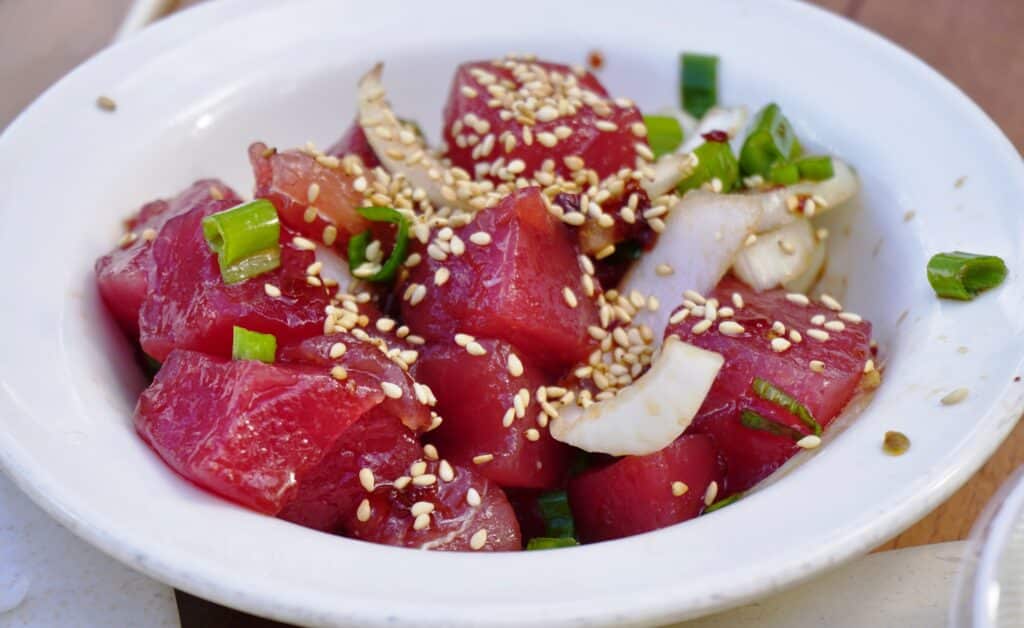
hawaiian poke bowl (Shutterstock)
What Makes an Authentic Hawaiian Ahi Tuna Poke Bowl?
A real Hawaiian poke bowl starts with high-quality, sashimi-grade fish. Ahi is the most popular fish, but other options like salmon, hamachi (yellowtail), and even octopus are widely available. Here’s what sets it apart:
- Fresh Fish – Locally caught when possible, and never previously frozen if you can help it.
- Simple Seasoning – Traditional poke uses sea salt, limu, and inamona. Soy sauce, sesame oil, green onions, and chili water are also common.
- Add-ins with a Purpose – No overcomplicated bowls with random toppings here. Hawai‘i-style poke is more about flavor and texture than presentation.
- Warm Rice (Optional) – Poke is often served on a bed of rice to make it a full meal, but many locals eat it straight from the container.
As @LocalCravingsHonolulu puts it, “The best poke bowls don’t need toppings. Just give me good fish and shoyu.”
The Importance of Sushi-Grade Tuna
Sushi-grade tuna is a cornerstone of authentic poke, providing the dish with its signature flavor and texture. Ahi tuna, in particular, is a favorite due to its rich taste and firm, buttery texture. When it comes to making poke, the quality of the fish is paramount. When you’re preparing your next poke bowl, remember the best dishes start with the best ingredients.
Selecting sushi-grade tuna means choosing fish that is exceptionally fresh and handled with the utmost care. Look for ahi tuna that boasts a vibrant color, a clean, ocean-fresh smell, and a firm texture. These qualities indicate that the fish is of high quality and safe to eat raw. It’s also crucial to purchase from reputable sources that follow strict handling and storage practices to ensure the fish remains uncontaminated.
Popular Poke Flavors
There are dozens of poke flavors in Hawai‘i, and every store puts its own spin on it. Some of the most popular include:
- Shoyu Ahi – Cubed tuna marinated in soy sauce, sesame oil, sweet onion, and green onion. A classic.
- Spicy Ahi – Tuna mixed with creamy, spicy mayo and tobiko (fish roe). Often served over rice.
- Limu Ahi – A nod to tradition, this version includes Hawaiian seaweed and roasted kukui nuts.
- Oyster Sauce Ahi – A savory, slightly sweet take with a rich umami flavor.
- Garlic Ahi – Marinated in garlic oil, often with a kick of chili pepper.
- Wasabi Ahi – A sharp, sinus-clearing flavor bomb for those who like heat.
- Salmon Poke – A buttery alternative to ahi, often paired with sweet onions or citrus.
- Hamachi Poke – Rich and delicate, it’s a favorite at more upscale poke spots.
Pro tip from @EatDaAloha: “Tamura’s spicy salmon is worth the hype. Creamy, spicy, and addictive!”
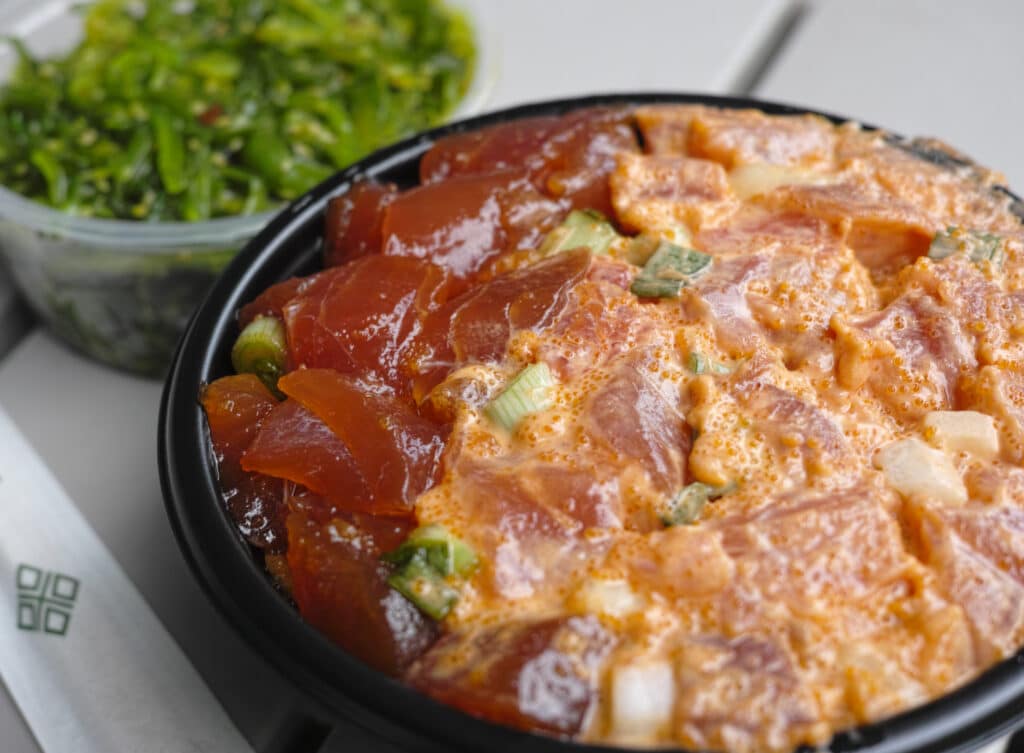
poke bowl (Shutterstock)
Customize Your Bowl
One of the joys of poke bowls is their versatility. Whether you crave spicy, savory, or sweet flavors, there’s a poke bowl combination that will satisfy your taste buds. Customizing your poke bowl allows you to create a meal that’s uniquely yours.
Start with a protein of choice. Ahi tuna is a classic, but don’t hesitate to explore other options like salmon, tofu, or even octopus. Next, choose your toppings. Seaweed salad, pickled ginger, and sesame seeds are popular choices that add texture and flavor. For an extra kick, drizzle some soy sauce or sesame oil over your bowl.
Here are a few popular combinations to inspire you:
- Spicy Ahi Tuna Poke: Combine ahi tuna with seaweed salad, pickled ginger, and a sprinkle of red pepper flakes for a spicy kick.
- Savory Salmon Poke: Pair salmon with sesame seeds, soy sauce, and sweet onions for a savory delight.
- Sweet Tofu Poke: Mix tofu with mango salsa, toasted coconut flakes, and a touch of toasted sesame oil for a sweet and tropical twist.
The possibilities are endless, so don’t be afraid to get creative. Mix and match ingredients to find your perfect poke bowl combination.
How to Order Poke at the Grocery Store
If you’re visiting Hawai‘i and want the real poke experience, skip the chain restaurants and head to the poke counter at a local supermarket. Stores like Foodland, KTA, Tamura’s, and Times have a wide selection — sometimes over 15 different kids. Each store has its own take, so don’t be surprised if the flavors vary from one location to the next.
Here’s how to navigate the poke bar like a pro:
- Look for the Counter – It’s usually near the deli or seafood section.
- Ask for Samples – Don’t be shy! Most places will happily give you a small taste before you commit. Sampling is common, especially if you’re unsure about a flavor.
- Order by the Pound or Container – A half-pound is a good size for one person. Some stores offer pre-packaged containers or will pack it fresh to order.
- Mix and Match – If you can’t decide, ask for two flavors in one container (usually allowed with a one-pound order).
- Know What You Like – If you like spicy, go for spicy ahi or wasabi poke. Prefer classic? Try shoyu or limu.
- Go Early – The best flavors sell out fast, especially around lunch or pau hana (after work).
- Add Rice if You Want a Bowl – Most counters sell plain or seasoned rice separately if you want a full poke bowl to-go.
- Bring a Cooler – If you’re taking it to the beach or on a road trip, ask for ice or pack a cooler to keep it fresh.
- Chat with the Staff – Ordering poke in Hawai‘i is casual and friendly. Don’t be afraid to ask what they recommend. You might just find a new favorite!
Why Poke Is the Perfect Potluck Dish
In Hawai‘i, potlucks are a way of life, and poke is always the first bowl to get scraped clean. It’s easy to transport, requires no heating or refrigeration (for a few hours at least), and everyone loves it. You can dress it up with furikake, avocado, or even crispy onions if you’re feeling fancy, but it really doesn’t need much.
When I bring poke to gatherings, I always get asked, “Where’d you get this one?” It’s like showing up with your signature dish — and bonus points if you picked it up from a hidden gem spot.
Making Hawaiian Poke at Home
Craving poke but not in Hawai‘i? Bring the flavor of the islands to your kitchen. Here’s a simple Hawaiian ahi poke recipe you can make at home:
Ingredients:
- 1 lb sashimi-grade ahi tuna, cubed
- 1/4 cup shoyu (soy sauce)
- 1 tsp sesame oil
- 1/2 tsp Hawaiian sea salt (or kosher salt)
- 1/4 cup chopped green onions
- 2 tbsp sweet Maui onion, finely chopped
- 1 tbsp limu (or wakame seaweed), rehydrated
- 1 tbsp inamona (optional)
Instructions:
- In a large bowl, gently mix all the ingredients.
- Cover and chill in the fridge for at least 30 minutes to let the flavors meld.
- Serve on its own, over warm rice, or with sliced avocado and cucumber.
Explore our full guide to Hawaiian cuisine for more local favorites.
Safety and Handling of Raw Fish
Handling raw fish safely is crucial when making poke to prevent contamination and food borne illness. Here are some essential tips to ensure your poke bowls are both delicious and safe:
- Purchase Sushi-Grade Fish: Always buy from reputable sources that guarantee the fish is sushi-grade.
- Handle with Care: Use clean utensils and cutting boards to avoid cross-contamination.
- Proper Storage: Store the fish in a sealed container in the refrigerator at 40°F (4°C) or below.
- Timely Consumption: Consume the fish within a day or two of purchase, or freeze it for later use.
- Check Freshness: Always inspect the fish for freshness and quality before using it.
Are Poke Bowls Healthy?
Poke bowls can be a nutritious and balanced meal, depending on the ingredients and portion sizes. Here are some reasons why poke bowls are a healthy choice:
- Protein-Rich: Raw fish like ahi tuna is an excellent source of protein and omega-3 fatty acids.
- Nutrient-Dense: Seaweed salad is packed with vitamins and minerals, including vitamin K and iodine.
- Healthy Fats: Sesame seeds and sesame oil provide healthy fats and antioxidants.
- Whole Grains: Using brown rice or other whole grains adds fiber and essential nutrients.
To make your poke bowl even healthier, consider these tips:
- Lean Proteins: Opt for lean protein sources like ahi tuna or tofu.
- Low-Sodium Options: Choose low-sodium soy sauce and seasonings.
- Vegetable-Rich: Add plenty of vegetables like seaweed salad and pickled ginger.
- Whole Grains: Use brown rice or other whole grains instead of white rice.
- Moderate High-Calorie Ingredients: Go easy on sesame oil and other high-calorie toppings.
With these simple adjustments, you can enjoy a delicious and nutritious poke bowl that’s perfect for a quick and healthy meal.
Poke is a Taste of Hawai‘i
Whether you’re relaxing at Lanikai Beach, stocking up for a party, or sampling from a poke counter in Hilo, eating poke in Hawai‘i is more than just grabbing a meal. It connects you to the islands, the ocean, and a culinary tradition that has deep roots. It’s the kind of food that makes you close your eyes, smile, and say, “Broke da mouth.”








